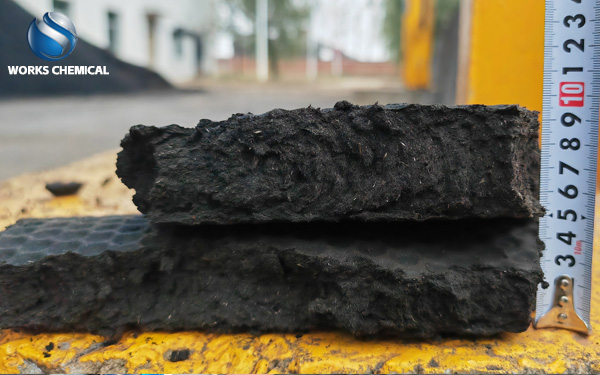
During the sludge treatment process, common problems such as incomplete sludge pressing, soft-centered sludge cakes, and long sludge pressing time not only affect the treatment efficiency but also increase the treatment cost. As a specialized chemical conditioner, the sludge enhancer can effectively solve these problems and achieve efficient sludge dewatering through the synergistic effect of multiple components. The following is the specific analysis:

I. Technical Principle: Breaking through the bottleneck of sludge dewatering with multiple targets
The core advantage of the sludge enhancer lies in its compound formula design, which achieves efficient dewatering through the following three major mechanisms:
Destroy the colloid structure
The inorganic compounds and surface structure modifiers in the sludge enhancer can penetrate into the interior of the sludge colloid. Through charge neutralization and bridging, they break down the double electric layer structure of the colloid, causing the sludge particles to lose their repulsive force and creating conditions for subsequent dewatering.
Reduce the viscosity of sludge
Through the synergistic effect of cell wall breaking agents and degreasing agents, extracellular polymers (EPS) and lipid substances in the sludge are decomposed, significantly reducing the viscosity of the sludge. For instance, a case from a certain sewage treatment plant shows that after using the enhancer, the viscosity of the sludge decreased by 60%, and the clogging rate of the filter cloth in the filter press dropped by 40%.
Release bound water
Sludge enhancers can destroy the double electric layer structure of the original bacterial flocs in sludge particles, release the water inside the ionic hydration membrane layer (including internal free water, interstitial water and part of the bound water), reduce the Zeta potential of sludge flocs, and improve the hydrophobicity of sludge.
Ii. Application Effect: Precise resolution of difficult problems
Increase the consistency of the mud biscuits
When used in combination with plate and frame filter presses, the sludge enhancer can reduce the moisture content of sludge from over 90% to 40%-60%. For instance, after a certain sewage treatment plant applied a sludge enhancer, the moisture content of the sludge cake dropped from 80% to below 60%, meeting the standards for landfill or incineration.
Solve the problem of runny cores
By improving the structure of the mud cake to make it more compact, the problem of a runny core can be solved. The use of sludge enhancers ensures good stability of the sludge cakes and facilitates subsequent treatment.
Shorten the sludge pressing time
Optimizing the parameters of the filter press (such as high-pressure feeding and high-pressure pressing) can shorten the pressing section time and improve production efficiency. The case shows that after using the sludge enhancer, the efficiency of the filter press has increased by 100% to 500%, and the sludge pressing cycle has been significantly shortened.
Iii. Industry Adaptability: Widely applicable to all types of sludge
Sludge enhancers are widely applicable to the dewatering and treatment of sludge from various industries such as municipal sludge, printing and dyeing sludge, papermaking sludge, electroplating sludge, chemical sludge, and leather sludge. Its strong adaptability enables different types of sludge to achieve efficient dewatering by adjusting the type and dosage of chemicals.
Iv. Key Points for Use: The key to ensuring the best effect
Dosage control
Adjust the dosage according to the nature of the sludge and the performance of the treatment equipment to avoid excessive or insufficient dosage. Generally speaking, the dosage is 0.5% to 2% of the dry sludge volume. It is recommended to determine the optimal dosage through small-scale tests.
Equipment collaborative optimization
It is deeply coordinated with equipment such as plate and frame filter presses and centrifuges, and combined with high-pressure pressing (1.0-1.4MPa) to improve the dewatering efficiency. Meanwhile, optimize parameters such as the filling degree of the filter press, the rate of pressure increase during pressing, and the retention time of the pressing pressure.
Precautions for operation
Select the appropriate model of sludge enhancer based on the characteristics of the sludge and the treatment requirements.
Regularly monitor the dewatering effect, moisture content and other indicators of sludge to ensure the effectiveness of sludge enhancers.
Comply with relevant environmental protection regulations and standards to ensure that the treated sludge meets environmental protection requirements.
V. Case Verification: The actual effect is remarkable
A municipal sewage treatment plant: After using the sludge enhancer, the sludge dewatering efficiency increased by more than 30%, the moisture content of the sludge cake dropped from 80% to below 60%, and the treatment cost was significantly reduced.
A certain printing and dyeing factory: The use of sludge enhancer has increased the automatic shedding rate of mud cakes, reduced the frequency of filter cloth cleaning by 50%, and cut the equipment operation time by 30%.
Conclusion
The sludge efficiency enhancer takes technological innovation as its core. Through multi-target action mechanisms and compound formula design, it effectively solves the problems of incomplete sludge pressing, soft-centered sludge cakes, and long sludge pressing time. Its remarkable application effects and wide range of application scenarios are promoting the sludge treatment industry to develop in a more efficient and environmentally friendly direction.